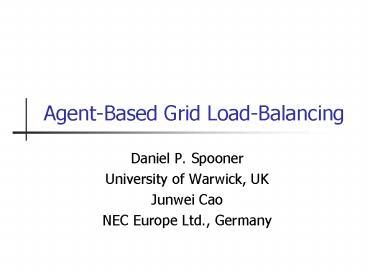Agent-Based Grid Load-Balancing - PowerPoint PPT Presentation
Title:
Agent-Based Grid Load-Balancing
Description:
Agent-Based Grid Load-Balancing Daniel P. Spooner University of Warwick, UK Junwei Cao NEC Europe Ltd., Germany Outline Grid Computing & Middleware Agent-Based ... – PowerPoint PPT presentation
Number of Views:148
Avg rating:3.0/5.0
Title: Agent-Based Grid Load-Balancing
1
Agent-Based Grid Load-Balancing
- Daniel P. Spooner
- University of Warwick, UK
- Junwei Cao
- NEC Europe Ltd., Germany
2
Outline
- Grid Computing Middleware
- Agent-Based Methodology
- Distributed Service Discovery
- Grid Load-Balancing
- Experimental Results
- Conclusions Future Work
3
Grid Computing
- Computational Grids - blueprint for a new
computing infrastructure
V
- Data/Service/Community Grids - large-scale
resource sharing in VOs
- Grid/Web Services - distributed system and
application integration
4
Grid Middleware
- Resource Management Scheduling
- Information Services (Monitoring Discovery)
- Data Management and Access
- Application Programming Environments
- Security, Accounting, QoS
- Condor, LSF, Ninf, Nimrod,
- Globus, Legion, DPSS,
- Java/Jini, CORBA, Web Services,
5
Grid Resource Management
- Key challenges
- Cross-domain
- Large-scale
- Dynamic
- QoS support
GRM
6
Agent-Based Methodology
- An agent is
- A local grid manager
- An user agent
- A broker
- A service provider
- A service requestor
- A matchmaker
A
A
A
A
7
Local Management
- Performance Prediction
- Task models
- Hardware models
FIFO Algorithm
- Genetic Algorithm
- Heuristic Evolutionary
- Near-optimal on makespan, deadlines and idletime.
8
Service Discovery
- Pure data-pull
- No advertisement
- Full discovery
- Efficient when service change more quickly
- Pure data-push
- Full advertisement
- No discovery
- Efficient when requests arrive more frequently
Centralised, not applicable for grid computing!
9
Optimisation Strategies
- Configurable data-pull or data-push
- Agent hierarchy
- Multi-step advertisement multi-step discovery
- Efficient when frequencies of request arrivals
and service changes are almost the same
A
Distributed! balancing between advertisement
and discovery!
User
10
Agent Implementation
Task Execution
Resource Monitoring
Task Execution
Task Management
FIFO/GA Scheduling
Service Info. Provider
Sched. Time
Task Execution
Current Makespan
FIFO Scheduling
Match Maker
Database Management
Service Info
User Deadline
Results
Hw Model
Performance Prediction
Task Model
Advertisement
Discovery
To Another Agent
11
Load Balancing Metrics
- Total makespan
- Average advance time of task execution
completions (required deadline - actual task
completion time) - Average processor utilisation rate (busy time /
total makespan) - Load balancing level (1 - mean square deviation
of processor utilisation rates / average
processor utilisation rate) - Total number of network packages for both
advertisement and discovery
12
Experiment Design
- Tasks
- sweep3d
- fft
- improc
- closure
- jacobi
- memsort
- cpi
13
Experiment 1
14
Experiment 2
15
Experiment 3
16
Task Execution
Both GA and agents contribute towards the
improvement in task executions.
17
Resource Utilisation
Less powerful S11 S12 benefit mainly from the
GA. More powerful S1 S2 benefit mainly from
agents.
18
Load Balancing
The GA contributes more to local grid load
balancing. Agents contribute more to global
grid load balancing.
19
Total Makespan
The centralised pure data-pull can always achieve
the best results Distributed agents with the
hierarchical model can also achieve reasonably
good results
20
Network Package
The network overhead for the pure data-pull
strategy to achieve better results is very
high. Distributed agent-based service
advertisement and discovery can scale well.
21
Conclusions
- An multi-agent paradigm provides a clear
high-level abstraction of grid resource
management system. - Distributed service advertisement and discovery
strategies can be used to improve agent
performance. - Agent-based framework is scalable, flexible, and
extensible for further enhancements.






























